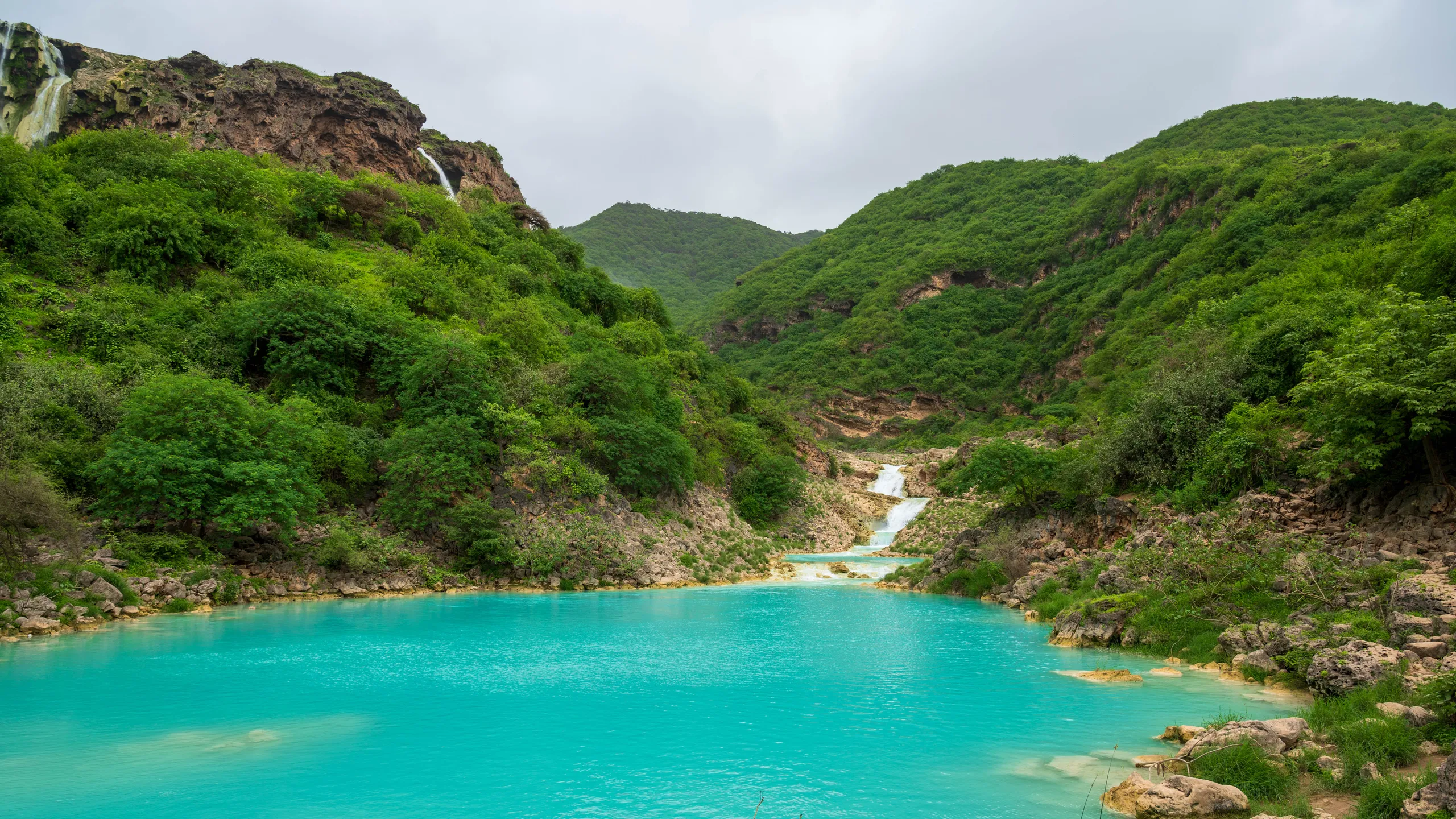



Salalah is the capital city of southern Oman's Dhofar province. It's known for its banana plantations, Arabian Sea beaches and waters teeming with sea life. The Khareef, an annual monsoon, transforms the desert terrain into a lush, green landscape and creates seasonal waterfalls. The Frankincense Land Museum, part of the Al Balid Archaeological Site, recounts the city’s maritime history and role in the spice trade.
Monsoon Season (Khareef) – June to September: The best time to visit Salalah for lush greenery, cooler temperatures (20–25°C), and the Khareef (monsoon) season, which transforms the region into a green paradise.
Winter (October to March): A great time for those who want to explore the outdoors with pleasant weather (20–30°C), ideal for sightseeing and outdoor activities.
Summer (April to May): The temperature can rise to above 35°C, but it’s less crowded compared to the Khareef season.
By Air:
Salalah International Airport (SLL) is the main gateway with direct flights from Muscat, Dubai, and other international destinations.
By Car:
Salalah is about a 12-hour drive from Muscat (1,000 km), or a scenic 8-hour drive from the UAE border along the coastal route.
By Bus:
There are long-distance buses connecting Muscat to Salalah, but they may take a longer time compared to driving.
Wadi Darbat – A picturesque valley with waterfalls, lakes, and hiking trails, especially beautiful during the Khareef season.
Al Baleed Archaeological Park – A UNESCO World Heritage site with ruins of ancient civilizations and a museum showcasing Oman’s history.
Sultan Qaboos Mosque – One of the largest mosques in Salalah, with stunning architecture and peaceful surroundings.
Frankincense Land of Oman Museum – Explore Oman’s historical connection to frankincense production, a major export in ancient times.
Samhan Mountain Reserve – A nature reserve offering breathtaking views, wildlife sightings, and hiking opportunities.
Mirbat Beach – A serene, quiet beach near Mirbat village with stunning views and clear waters.
Taqah Castle – A restored 19th-century castle with great insight into the region’s history.
Khor Rori (Sumhuram) – An archaeological site that was once a thriving city and an important port for frankincense trade.
Al Mughsail Beach – Known for its dramatic blowholes and stunning cliff views, especially during the Khareef season.
Jabal Al Qamar (Moon Mountain) – A stunning hill with panoramic views of the surrounding landscape and coastline.
Hike at Wadi Darbat – Explore waterfalls, caves, and natural pools during the Khareef season.
Visit Al Baleed Archaeological Park – Discover the rich history and culture of Salalah at this UNESCO World Heritage site.
Relax at Al Mughsail Beach – Walk along the shore or enjoy the coastal scenery, especially the blowholes.
Explore Khor Rori – Visit the ancient city ruins by the sea and learn about Salalah’s frankincense trade history.
Go Dolphin Watching in the Arabian Sea – Salalah offers opportunities for dolphin and whale watching, especially from the coastal areas.
Visit the Frankincense Land Museum – Learn about the historical significance of frankincense in Oman.
Drive through Samhan Mountain Reserve – Take a scenic drive through the reserve with panoramic views and wildlife.
Cultural Experiences at Taqah Castle – Explore the castle and learn about the region’s local history.
Visit the Sultan Qaboos Mosque – Take a moment of peace and admire the architectural beauty of the mosque.
Beach Activities at Mirbat Beach – Enjoy water sports, swimming, and snorkeling in a peaceful environment.
Luxury:
Al Baleed Resort Salalah by Anantara – A 5-star resort offering luxurious accommodations with beach access and private villas.
Salalah Rotana Resort – A beachfront resort with excellent amenities and beautiful gardens.
Hilton Salalah Resort – A beachfront resort with great facilities and stunning views of the Arabian Sea.
Mid-Range:
Mysk Al Mouj Hotel – A contemporary hotel offering comfortable rooms and good service.
Salalah Plaza Hotel – A good budget-friendly option with modern amenities and a central location.
Budget:
Khaled Hotel – A budget-friendly option with basic facilities in the heart of Salalah.
Crown Plaza Hotel Salalah – Affordable yet comfortable with convenient access to popular areas.
Traditional Omani Cuisine:
Bin Ateeq Restaurant – Famous for its Omani dishes such as Shuwa (slow-cooked lamb) and Mashuai (rice and fish).
Al Fawar Restaurant – A great place for traditional Omani and Arabic meals.
Casual Dining & Cafés:
Tarbouche – A Lebanese restaurant serving delicious shawarma, falafel, and grilled meats.
Sultanah Restaurant – Known for its variety of Middle Eastern and international dishes.
Fine Dining & International Cuisine:
The Beach Restaurant – A beachfront dining experience offering seafood and international cuisine.
Dhofar Arbia Restaurant – A fine-dining restaurant serving a mix of Omani and Arabian flavors.
Local Delicacies to Try:
Shuwa – Slow-cooked lamb marinated with spices, served during celebrations.
Mashuai – A dish made of rice, fish, and dried shrimp, often served with dates.
Dates and Frankincense-flavored desserts – A must-try treat for anyone visiting Salalah.
Khareef Festival: During the monsoon season, Salalah celebrates the Khareef festival, showcasing music, dance, and local handicrafts.
Frankincense Tradition: Salalah is known for its production of frankincense, and visitors can experience the cultural significance of this trade in museums and markets.
Hospitality: Omanis are known for their warm hospitality, and visitors are often greeted with Arabic coffee and dates.
Dress Modestly: While Oman is relatively liberal, it’s advisable to dress conservatively in public, especially in religious places.
Arabic Language: Arabic is the primary language, but English is widely spoken in tourist areas.
Islamic Holidays: During Ramadan, eating, drinking, or smoking in public places during daylight hours is prohibited.